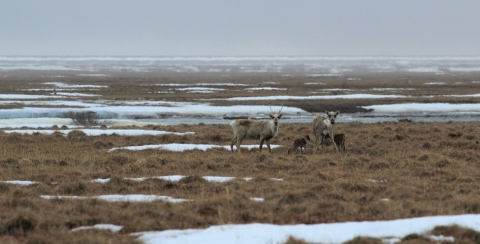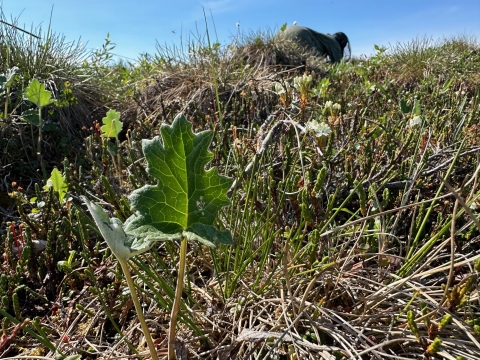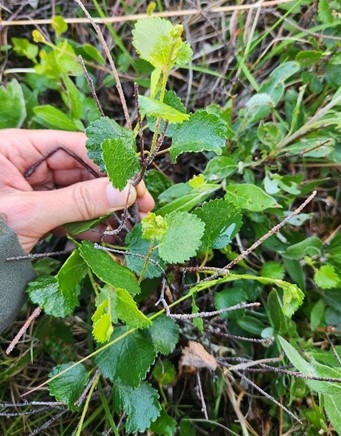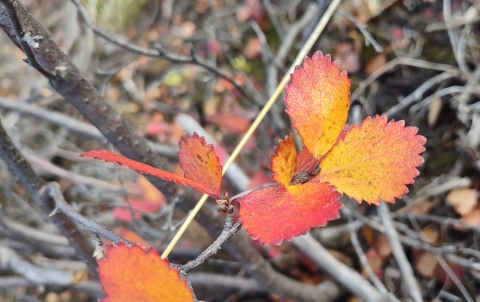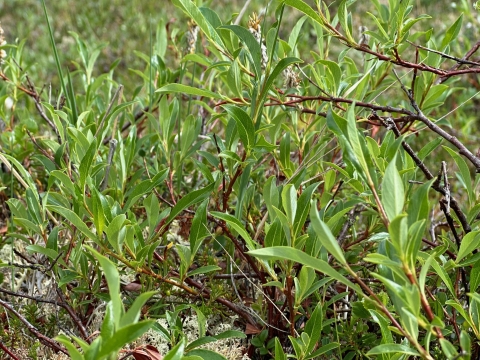A view of the Coastal Plain of the Arctic National Wildlife Refuge in early June, looking south toward the Sadlerochit mountains. Maria Berkeland/USFWS
While flying over the coastal plain of the Arctic National Wildlife Refuge on a sunny day in early June, you look down and notice many little brown dots, most with even smaller dots next to them, scattered across the lighter brown tundra. These little brown dots are cow (female) caribou and their calves, all members of the Porcupine caribou herd. The coastal plain of northeast Alaska and northwest Canada is the herd’s calving ground. The whole herd spends the winter months spread out across the Brooks Range mountains and foothills to the south. In late March, the cow caribou begin their long walk north, arriving on the coastal plain tundra in May to give birth as the snow melts from the landscape. The bull (male) caribou join them later in the summer as they begin their slow meander south, grazing as they move.
Researchers from the National Park Service have found that over the course of a year, the Porcupine caribou herd completes the longest overland migration of any terrestrial mammal on earth. Why do cow caribou travel roughly 450 miles every spring to reach the coastal plain? How are changes in climate influencing the coastal plain and surrounding habitats, and in turn, the Porcupine caribou herd? Researchers from the U. S. Geological Service (USGS), U. S. Fish and Wildlife Service (USFWS), Parks Canada, Yukon Government, and Texas A&M University are investigating these questions. The plants that caribou eat on the Arctic tundra may hold some answers.
Cow barren ground caribou (Rangifer tarandus) with newborn calves on the Coastal Plain on a foggy day in early spring. Maria Berkeland/USFWS
In 2021, researchers determined the summer diet of the Porcupine herd by using video-equipped camera collars that they had placed on the necks of cow caribou. The cameras collected a 10-second video every 20 minutes throughout the spring and summer. Analysis of the camera data began with someone (oftentimes a trained citizen scientist) watching the video and describing the observed behaviors. When a caribou was observed foraging, a botanist would then watch the video to determine the plant or lichen species being eaten. Samples were then collected of the plants and lichens that were most frequently consumed by caribou across their summer range, which includes the coastal plain, foothills, and mountains of the Brooks Range.
Camera collar video of a caribou foraging on tussock cottongrass (Eriophorum vaginatum). Video courtesy of USGS
Based on the video data, the most common plant species consumed during the summer were diamond-leaf willow, netleaf willow, dwarf birch, Arctic sweet coltsfoot, and tussock cottongrass, and the most common lichen species was curled snow lichen.
Photo of curled snow lichen (Flavocetraria cucullate), white bits that look like curled paper, mixed with tundra plants and leaves. Fingertip added to indicate scale. Maria Berkeland/USFWS
Video of tussock cottongrass heads and then panning to the Coastal Plain with the Brooks Range in the background. The cottongrass heads are one of the Porcupine caribou’s favorite foods in the springtime. Maria Berkeland/USFWS
Photo of Arctic sweet coltsfoot (Petasites frigidus), the large single leaves in front, with a few more plants in the background. Heather Johnson/USGS
Photos of dwarf birch (Betula nana) in summer (top) and fall (bottom). Photo on top shows a shrub in the summer, while the photo on the bottom shows a close-up twig with leaves in fall.
Top – Heather Johnson/USGS Bottom – Maria Berkeland/USFWS
Photo of diamond-leaf willow (Salix pulchra) growing in the Brooks Range. Heather Johnson/USGS
Photo of netleaf willow (Salix reticulata), the small shrub in the center, growing in Arctic Refuge. The bright red bulbs on the right-most leaf are not berries, but galls -- likely caused by bacteria, fungi, or insects. Heather Johnson/USGS
For this ongoing project, biologists will analyze the nutrient content of plant and lichen samples after they are collected from the caribou’s summer range The nutritional value, which varies across different areas of the summer range and across the growing season , is determined by quantifying the energy, protein, and mineral content of the samples. Researchers will use the nutrient information to model variation in forage conditions across the summer range of the Porcupine caribou herd. The models will predict and map forage conditions for caribou under changing environmental conditions, enabling biologists to determine where and when caribou can find the most nutritious forage, especially during the critical calving and post-calving seasons.
In addition to looking at caribou forage and nutrition, researchers also use the video collar data to understand the impact of pesky biting insects on the Porcupine caribou herd. As changes in climate cause earlier and longer Arctic growing seasons, insect activity is expected to increase in severity and duration. This could challenge caribou because responding to insect harassment reduces the time caribou spend foraging, while simultaneously increasing the energy they expend running or seeking refuge in cooler, windier areas on water, gravel, or snowfields. USGS researchers have found that these energy expenditures can result in a subsequent decline in caribou survival and reproduction.
The diet, movements, and behaviors of the Porcupine caribou herd are likely to shift in conjunction with climate-driven changes in both forage and insects. Understanding how caribou respond to these changes is important for identifying critical habitat areas and predicting future population trends. By using a combination of video collars, field sampling, and laboratory analyses, researchers are examining caribou responses to changing habitat conditions and gleaning information that could help manage and conserve the herd.
Camera collar video of a caribou shaking its head and moving around, due to insects. Video courtesy of USGS
The research described in this article is overseen by USGS Biologist Heather Johnson. Research publications for this ongoing project are expected to be published in the next five years.
Sources (and where you can find more information):
Joly, K., Gurarie, E., Sorum, M.S. et al. (2019). Longest terrestrial migrations and movements around the world. Sci Rep 9, 15333. https://www.nature.com/articles/s41598-019-51884-5
Johnson et al. (2022). Survival and reproduction in Arctic caribou are associated with summer forage and insect harassment. Frontiers in Ecology and Evolution 10:899585. https://pubs.usgs.gov/publication/70236931


